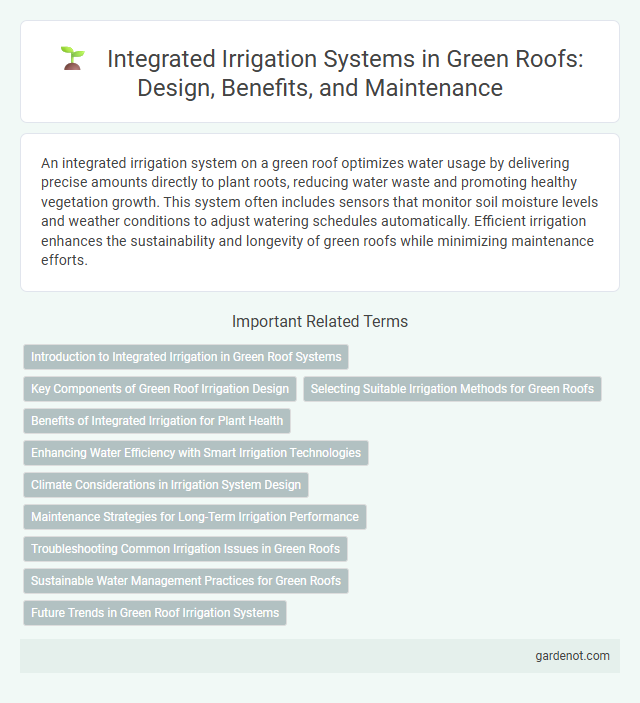An integrated irrigation system on a green roof optimizes water usage by delivering precise amounts directly to plant roots, reducing water waste and promoting healthy vegetation growth. This system often includes sensors that monitor soil moisture levels and weather conditions to adjust watering schedules automatically. Efficient irrigation enhances the sustainability and longevity of green roofs while minimizing maintenance efforts.
Introduction to Integrated Irrigation in Green Roof Systems
Integrated irrigation systems in green roof applications utilize advanced sensors and automated controls to efficiently manage water distribution, ensuring optimal plant health and reducing water waste. These systems combine moisture sensors, weather data, and drip irrigation technology to tailor watering schedules specifically to the microclimate of the green roof. The result is a sustainable solution that enhances plant growth, minimizes runoff, and conserves resources in urban environments.
Key Components of Green Roof Irrigation Design
Key components of a green roof irrigation design include a drip irrigation system, moisture sensors, and a water-efficient controller to optimize water usage. The drip irrigation system ensures targeted watering directly to the root zone, reducing evaporation and runoff. Moisture sensors monitor soil moisture levels in real time, enabling the controller to adjust irrigation schedules based on environmental conditions, enhancing plant health and conserving water.
Selecting Suitable Irrigation Methods for Green Roofs
Choosing suitable irrigation methods for green roofs involves evaluating water efficiency, plant species, and building structure. Drip irrigation and subsurface irrigation systems are preferred due to their precision in water delivery and minimal evaporation loss. Integrating smart sensors enhances water conservation by adjusting irrigation schedules based on soil moisture and weather conditions.
Benefits of Integrated Irrigation for Plant Health
An integrated irrigation system on green roofs ensures precise water delivery, promoting optimal soil moisture levels that enhance plant health and growth. By reducing water stress and preventing overwatering, the system supports root development and nutrient absorption, leading to more resilient vegetation. Efficient water use also minimizes resource waste, contributing to sustainable green roof maintenance and long-term ecosystem stability.
Enhancing Water Efficiency with Smart Irrigation Technologies
Smart irrigation technologies in green roofs significantly enhance water efficiency by using sensors and automated controls to monitor soil moisture levels and weather conditions. These integrated systems reduce water waste by delivering precise amounts of water tailored to the plant's needs, promoting healthier vegetation and minimizing runoff. Advanced components such as drip irrigation and real-time feedback loops optimize water usage, contributing to sustainable urban water management.
Climate Considerations in Irrigation System Design
Designing an integrated irrigation system for green roofs requires careful consideration of local climate patterns, including temperature fluctuations, rainfall variability, and seasonal droughts. Systems must optimize water use efficiency by incorporating sensors and automated controls that adjust irrigation schedules based on real-time weather data and soil moisture levels. Understanding regional microclimates ensures sustainable water management, reduces runoff, and promotes healthy vegetation growth on green roofs.
Maintenance Strategies for Long-Term Irrigation Performance
Integrated irrigation systems on green roofs require routine maintenance to ensure consistent water distribution and system longevity. Regular cleaning of filters, inspection of emitters, and timely repair of leaks prevent clogs and water wastage, enhancing irrigation efficiency. Implementing remote monitoring technology allows for precise water management, reducing runoff and sustaining plant health over the long term.
Troubleshooting Common Irrigation Issues in Green Roofs
Integrated irrigation systems for green roofs often encounter common issues such as clogged emitters, uneven water distribution, and sensor malfunctions. Regular inspection of drip lines and filters prevents blockages, while recalibrating moisture sensors ensures accurate irrigation cycles tailored to specific plant needs. Addressing these problems enhances water efficiency and promotes healthy vegetation growth on green roofs.
Sustainable Water Management Practices for Green Roofs
Integrated irrigation systems in green roofs utilize rainwater harvesting and moisture sensors to optimize water use efficiency, significantly reducing reliance on municipal water supplies. These sustainable water management practices enhance plant health and mitigate urban heat island effects by maintaining consistent soil moisture levels. Employing drip irrigation and automated controls minimizes water waste, promoting long-term ecological resilience and cost savings.
Future Trends in Green Roof Irrigation Systems
Future trends in green roof irrigation systems emphasize smart, sensor-driven technology that optimizes water usage by monitoring soil moisture and weather conditions in real-time. Integration of AI-powered irrigation controllers enables precise water delivery, reducing waste and promoting sustainable urban landscaping. Advances in renewable energy-powered pumps and IoT connectivity further enhance the efficiency and responsiveness of integrated irrigation systems on green roofs.
Integrated irrigation system Infographic

 gardenot.com
gardenot.com